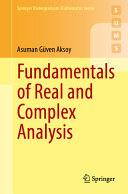

Most ebook files are in PDF format, so you can easily read them using various software such as Foxit Reader or directly on the Google Chrome browser.
Some ebook files are released by publishers in other formats such as .awz, .mobi, .epub, .fb2, etc. You may need to install specific software to read these formats on mobile/PC, such as Calibre.
Please read the tutorial at this link: https://ebookbell.com/faq
We offer FREE conversion to the popular formats you request; however, this may take some time. Therefore, right after payment, please email us, and we will try to provide the service as quickly as possible.
For some exceptional file formats or broken links (if any), please refrain from opening any disputes. Instead, email us first, and we will try to assist within a maximum of 6 hours.
EbookBell Team

5.0
30 reviewsThe primary aim of this text is to help transition undergraduates to study graduate level mathematics. It unites real and complex analysis after developing the basic techniques and aims at a larger readership than that of similar textbooks that have been published, as fewer mathematical requisites are required. The idea is to present analysis as a whole and emphasize the strong connections between various branches of the field. Ample examples and exercises reinforce concepts, and a helpful bibliography guides those wishing to delve deeper into particular topics. Graduate students who are studying for their qualifying exams in analysis will find use in this text, as well as those looking to advance their mathematical studies or who are moving on to explore another quantitative science.
Chapter 1 contains many tools for higher mathematics; its content is easily accessible, though not elementary. Chapter 2 focuses on topics in real analysis such as p-adic completion, Banach Contraction Mapping Theorem and its applications, Fourier series, Lebesgue measure and integration. One of this chapter’s unique features is its treatment of functional equations. Chapter 3 covers the essential topics in complex analysis: it begins with a geometric introduction to the complex plane, then covers holomorphic functions, complex power series, conformal mappings, and the Riemann mapping theorem. In conjunction with the Bieberbach conjecture, the power and applications of Cauchy’s theorem through the integral formula and residue theorem are presented.